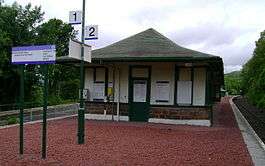Garelochhead railway station
| Garelochhead | |
|---|---|
| Scottish Gaelic: Ceann a' Gheàrrloch[1] | |
 | |
| Location | |
| Place | Garelochhead |
| Local authority | Argyll and Bute |
| Coordinates | 56°04′48″N 4°49′31″W / 56.0801°N 4.8254°WCoordinates: 56°04′48″N 4°49′31″W / 56.0801°N 4.8254°W |
| Grid reference | NS242910 |
| Operations | |
| Station code | GCH |
| Managed by | Abellio ScotRail |
| Number of platforms | 2 |
|
Live arrivals/departures, station information and onward connections from National Rail Enquiries | |
| Annual rail passenger usage* | |
| 2012/13 |
|
| 2013/14 |
|
| 2014/15 |
|
| 2015/16 |
|
| 2016/17 |
|
| Passenger Transport Executive | |
| PTE | SPT |
| History | |
| Original company | West Highland Railway |
| Pre-grouping | North British Railway |
| Post-grouping | LNER |
| 7 August 1894[2] | Opened |
| National Rail – UK railway stations | |
| * Annual estimated passenger usage based on sales of tickets in stated financial year(s) which end or originate at Garelochhead from Office of Rail and Road statistics. Methodology may vary year on year. | |
|
| |
Garelochhead railway station (Scottish Gaelic: Ceann a' Gheàrrloch) is a railway station serving the village of Garelochhead, on the Gare Loch, in Scotland. This station is on the West Highland Line and is a boundary station for SPT.
History
This station opened to passengers on 7 August 1894.[2]
The station was laid out with a crossing loop and an island platform. There were sidings on both sides, and a turntable on the west side of the line. Until the 1960s, the station was served by a local shuttle service between Craigendoran and Arrochar & Tarbet in addition to main line trains to Fort William and Mallaig. Latterly operated by a Wickham diesel railbus, it fell victim to the Beeching Axe in June 1964.[3]
The siding on the east side was removed in 1983. On 15 February 1987, the crossing loop was altered to right-hand running. The original Down platform has thus become the Up platform, and vice versa. The change was made to simplify shunting at this station, by removing the need to hand-pump the train-operated loop points to access the siding.
Signalling
From the time of its opening in 1894, the West Highland Railway was worked throughout by the electric token system. Garelochhead signal box, which had 18 levers, was situated on the island platform.
The semaphore signals were removed on 2 February 1986 in preparation for the introduction of Radio Electronic Token Block (RETB) by British Rail. The RETB, which is controlled from a Signalling Centre at Banavie railway station, was commissioned between Helensburgh Upper and Upper Tyndrum on 27 March 1988.
The Train Protection & Warning System was installed in 2003.
Services
| Preceding station | Following station | |||
|---|---|---|---|---|
| Helensburgh Upper | Abellio ScotRail West Highland Line |
Arrochar & Tarbet | ||
| Helensburgh Upper | Caledonian Sleeper Highland Caledonian Sleeper |
Arrochar & Tarbet | ||
| Historical railways | ||||
| Shandon Line open; Station closed |
West Highland Railway North British Railway |
Whistlefield Halt Line open; Station closed | ||
2011
Mondays to Saturdays, there are three services to Oban and Mallaig and one service to Fort William (Highland Caledonian Sleeper) northbound. Southbound, there are four services to Glasgow Queen Street (three on Saturdays) and one service to London Euston (Highland Caledonian Sleeper does not run on Saturday). On Sundays, there is just one train northbound to Oban and Mallaig and two trains southbound to Glasgow Queen Street and London Euston.
2016
Mondays to Saturdays, there are six trains to Oban and three to Mallaig each day northbound (three of the Oban services run combined with those to Mallaig, splitting at Crianlarich), plus the Highland Sleeper to Fort William. Southbound, there are six trains to Glasgow Queen Street High Level plus the sleeper to Edinburgh Waverley and London Euston (this calls at Queen Street Low Level to set down only and does not run on Saturday evenings). On Sundays there are three trains to Oban all year and two to Mallaig in summer and one in the winter northbound and three trains to Glasgow southbound, along with the London sleeper.[4]
References
Notes
- ↑ Brailsford 2017, Gaelic/English Station Index.
- 1 2 Butt (1995), page 101
- ↑ "The 'Wee Arrochar'"Helensburgh Heritage Trust website; Retrieved 27 April 2016
- ↑ GB eNRT 2015-16 Edition, Table 227 (Network Rail)
Sources
- Brailsford, Martyn, ed. (December 2017) [1987]. Railway Track Diagrams 1: Scotland & Isle of Man (6th ed.). Frome: Trackmaps. ISBN 978-0-9549866-9-8.
- Butt, R. V. J. (1995). The Directory of Railway Stations: details every public and private passenger station, halt, platform and stopping place, past and present (1st ed.). Sparkford: Patrick Stephens Ltd. ISBN 978-1-85260-508-7. OCLC 60251199.
- Jowett, Alan (March 1989). Jowett's Railway Atlas of Great Britain and Ireland: From Pre-Grouping to the Present Day (1st ed.). Sparkford: Patrick Stephens Ltd. ISBN 978-1-85260-086-0. OCLC 22311137.
- RAILSCOT on the West Highland Railway
| Wikimedia Commons has media related to Garelochhead railway station. |